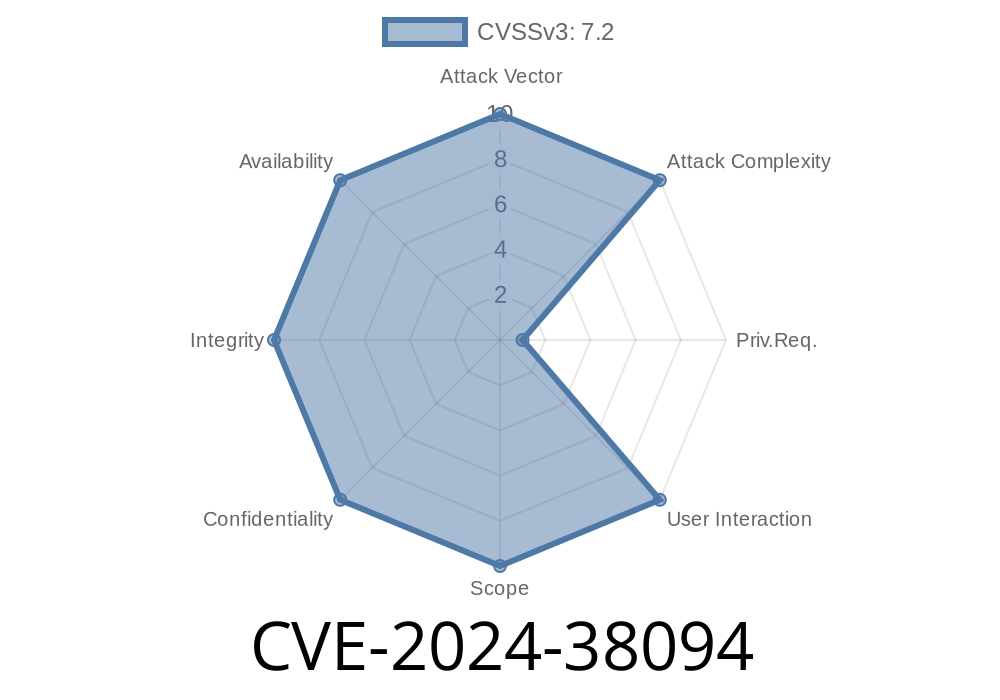CVE-2024-38094 - Microsoft SharePoint Remote Code Execution Vulnerability: Patch, Prevention, and Exploitation Details

In the ever-evolving world of cybersecurity, it's crucial to stay updated on vulnerabilities and exploits affecting popular software and platforms. In this post, we'll be discussing CVE-2024-38094, a recently discovered Microsoft SharePoint remote code execution vulnerability. SharePoint is a widely used collaboration platform, making this vulnerability important to address for individual users, employees, and IT admins alike.
We'll be diving into what this vulnerability is, the potentially malicious activities that can occur due to this exploit, and how you can protect your systems and networks. Additionally, we'll provide code snippets, links to original references, and exploit details.
Vulnerability Explained
CVE-2024-38094 refers to a Microsoft SharePoint Remote Code Execution Vulnerability, a critical flaw in SharePoint that can allow attackers to remotely execute arbitrary code on the target system. This can compromise the integrity, confidentiality, and availability of the affected system and its data.
According to the official CVE entry (https://cve.mitre.org/cgi-bin/cvename.cgi?name=CVE-2024-38094), this vulnerability is caused by "improper input validation in SharePoint server when processing Application Page (ASPX) files, leading to remote code execution." Asp.Net technology, which SharePoint is built upon, is built to be secure and robust; however, it is not immune to vulnerabilities.
To exploit this vulnerability, an attacker may craft a specially designed ASPX file with malicious code and use social engineering or other techniques to convince a user to upload it into a SharePoint site or might leverage the flaw for their benefit.
Exploiting the Vulnerability
To exploit the vulnerability, an attacker may use a specifically designed ASPX page. Here's an example of a potentially malicious code snippet that demonstrates how the vulnerability may be exploited:
<%@ Page Language="C#" %>
<%@ Import Namespace="System.Diagnostics" %>
<script runat="server">
void Page_Load(object sender, EventArgs e)
{
Process.Start("cmd.exe", "/c calc.exe");
}
</script>
This is just a sample code snippet and shouldn't be used for malicious purposes. The snippet demonstrates a basic payload that, when uploaded to SharePoint through the vulnerability, would execute a simple command, such as opening the calculator application. In a real attack scenario, a sophisticated attacker could deploy a much more harmful payload to compromise sensitive user data or system integrity.
Prevention and Mitigation
To protect against this vulnerability, organizations and users employing SharePoint servers must apply updates provided by Microsoft. Details about the patch and the update process can be found at the following link:
https://portal.msrc.microsoft.com/en-US/security-guidance/advisory/CVE-2024-38094
Additionally, it is crucial to update your SharePoint environment as soon as security patches are released to protect against similar vulnerabilities that may emerge. Here are general best practices to keep your SharePoint environment safe:
Regularly patch and update your software.
2. Restrict user permissions to the minimum necessary, including disallowing the upload of ASPX files by untrusted or unauthorized users.
Implement and maintain secure coding practices and security policies.
4. Train staff and users on cybersecurity awareness and best practices, such as identifying and avoiding social engineering attacks.
Conclusion
CVE-2024-38094 poses a significant threat to users and organizations that depend on Microsoft SharePoint for their collaboration needs. It's crucial to stay informed about this vulnerability and ensure that proper patches and security measures are in place to prevent potential exploitation.
By keeping your software up-to-date, following security best practices, and increasing user awareness, you can effectively mitigate the risks associated with this vulnerability and others like it. Stay safe, and continue to prioritize cybersecurity in your organization.
Timeline
Published on: 07/09/2024 17:15:46 UTC
Last modified on: 07/18/2024 23:03:34 UTC